Preparation – Begin by cleaning, and sanding your wood to create a smooth surface on to which you can transfer your pattern. Remove all sanding dust using a dusting brush and clean, dry cloth.
Chose Your Tracing Media – There are three primary tracing products which are graphite paper, carbon paper, newspaper, and a soft #4 to #8 artist pencil.
Please share on Facebook and Pintrest!
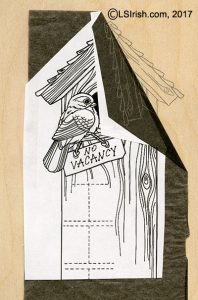 Graphite Paper – Graphite paper can be purchased through both office supply and craft stores. It comes in several colors, including gray, white, and blue for easy tracing onto different colors of wood. Graphite leaves a very fine line on the wood and can be erased with a white artist eraser after you have completed your project.
Graphite Paper – Graphite paper can be purchased through both office supply and craft stores. It comes in several colors, including gray, white, and blue for easy tracing onto different colors of wood. Graphite leaves a very fine line on the wood and can be erased with a white artist eraser after you have completed your project.
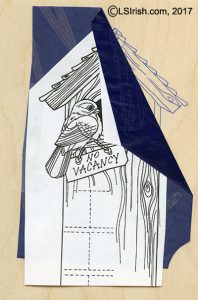 Carbon Paper – Carbon paper comes in 8 1/2″ x 11″ sheets and has a very dark, heavy layer of tracing media on the back surface. It is available in deep blue and black colors. Carbon paper lines do not erase easily and should be carved or scraped away as your work your project. Use this media on projects that will receive excessive handling or for long-term projects as it holds up very well. Because carbon paper was primarily used with typewriter to create multiple copies, you may need to do a little searching to find it.
Carbon Paper – Carbon paper comes in 8 1/2″ x 11″ sheets and has a very dark, heavy layer of tracing media on the back surface. It is available in deep blue and black colors. Carbon paper lines do not erase easily and should be carved or scraped away as your work your project. Use this media on projects that will receive excessive handling or for long-term projects as it holds up very well. Because carbon paper was primarily used with typewriter to create multiple copies, you may need to do a little searching to find it.
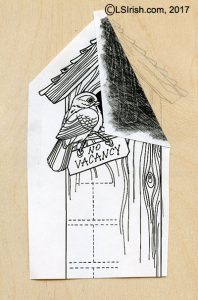 Pencil Rubbing – My favorite way to trace my pattern to the wood is to rub the back of the pattern paper with a #4 to #8 artist pencil. This creates a layer of graphite that will easily transfer to the wood surface as your copy the pattern lines with an ink pen. Pencil rubbings work extremely well for wood, gourds, and even leather. Woodless pencils work wonderfully for tracing.
Pencil Rubbing – My favorite way to trace my pattern to the wood is to rub the back of the pattern paper with a #4 to #8 artist pencil. This creates a layer of graphite that will easily transfer to the wood surface as your copy the pattern lines with an ink pen. Pencil rubbings work extremely well for wood, gourds, and even leather. Woodless pencils work wonderfully for tracing.
Newspaper – Heavily printed sheets of newspaper works wonderfully as a tracing media. As you trace along the pattern lines the printer’s ink from the newspaper will leave a dotted line on the wood. This process is especially good for extra large projects as out door signs or long, wide mantel boards. The ink is easily erased with a white artist’s eraser.
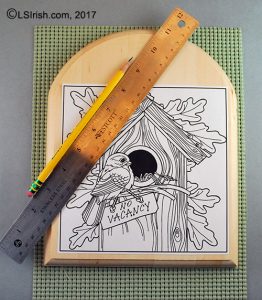 1. Adjust your digital pattern as necessary to fit your project piece. Print several copies of your pattern – one for the main tracing, one for cutting and tracing small areas of the pattern, and one for a reference to the detail lines of the design.
1. Adjust your digital pattern as necessary to fit your project piece. Print several copies of your pattern – one for the main tracing, one for cutting and tracing small areas of the pattern, and one for a reference to the detail lines of the design.
You will need a ruler, a small t-square or right angled triangle, a pencil, painters or masking tape, scissors, and several colors of ink pen. Of note, my ruler is cork-backed to grip the wood surface and keep the ruler from sliding.
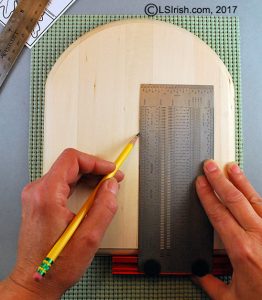 2. With a right angle triangle or small t-square mark the center vertical line of your project’s surface.
2. With a right angle triangle or small t-square mark the center vertical line of your project’s surface.
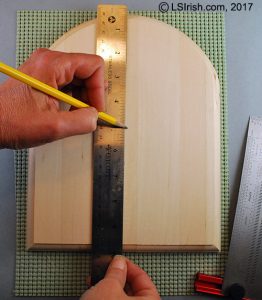 3. Use your ruler to find and mark the center point of your vertical line.
3. Use your ruler to find and mark the center point of your vertical line.
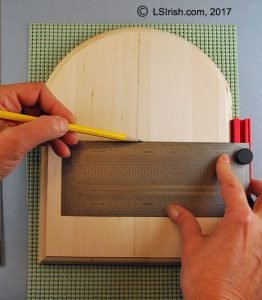 4. With the t-square or right angle triangle, draw a horizontal line across the project surface at the center point of the vertical line.
4. With the t-square or right angle triangle, draw a horizontal line across the project surface at the center point of the vertical line.
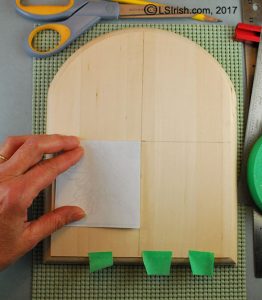 5. Fold your printed pattern into quarters, matching the outer pattern lines on the sides of the pattern. Place the folded pattern on to the wood, aligning the paper folds to the marked lines on the wood.
5. Fold your printed pattern into quarters, matching the outer pattern lines on the sides of the pattern. Place the folded pattern on to the wood, aligning the paper folds to the marked lines on the wood.
If you will using a pencil rubbing for your tracing media, open the folded pattern and rub the back of the pattern to completely cover it with pencil graphite. Refold your pattern and begin the positioning steps.
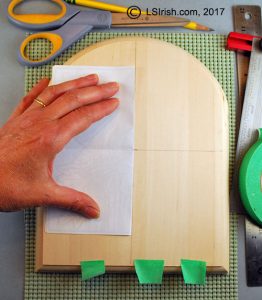 6. Unfold your pattern, continuing to match folds in the pattern paper with your guidelines. Cut several small strips of painters tape. Use the tape to secure two sides of the pattern paper to the wood surface.
6. Unfold your pattern, continuing to match folds in the pattern paper with your guidelines. Cut several small strips of painters tape. Use the tape to secure two sides of the pattern paper to the wood surface.
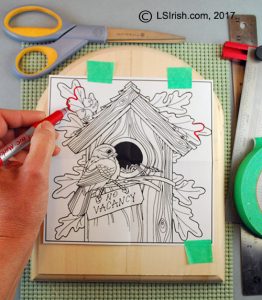 7. Use a colored ink pen to mark any changes you want to make in the pattern, so that you will follow your changes during the tracing process.
7. Use a colored ink pen to mark any changes you want to make in the pattern, so that you will follow your changes during the tracing process.
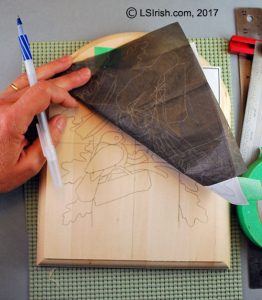 8. Slide your tracing media – graphite paper, carbon paper, newspaper – under the printed pattern with the tracing surface against the wood. Trace along the pattern lines with a colored ink pen. Use a light pressure, just enough to transfer the pattern line without leaving an indented score line from the ink pen’s point. When your tracing is complete lift the pattern paper at one of the un-taped corners. Check your work before you remove the pattern paper and tape.
8. Slide your tracing media – graphite paper, carbon paper, newspaper – under the printed pattern with the tracing surface against the wood. Trace along the pattern lines with a colored ink pen. Use a light pressure, just enough to transfer the pattern line without leaving an indented score line from the ink pen’s point. When your tracing is complete lift the pattern paper at one of the un-taped corners. Check your work before you remove the pattern paper and tape.
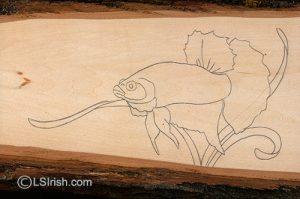 9. Trace only those lines that you really need for your initial working steps. For my Beta Fish relief carving I needed only the outlines of each area of the fish and the outlines of the grass to work the rough out carving steps.
9. Trace only those lines that you really need for your initial working steps. For my Beta Fish relief carving I needed only the outlines of each area of the fish and the outlines of the grass to work the rough out carving steps.
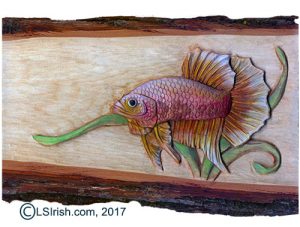 10. When your project work is done, remove any remaining tracing lines using a white artist’s eraser. Avoid colored erasers that can leave dye streaks on your carving or pyrography work.
10. When your project work is done, remove any remaining tracing lines using a white artist’s eraser. Avoid colored erasers that can leave dye streaks on your carving or pyrography work.
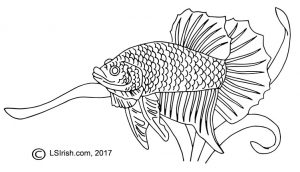 11. Click on the small image on the right for your free full-sized, printable Beta Fish pattern – a design from Relief Carving Workshop, by Lora Irish.
11. Click on the small image on the right for your free full-sized, printable Beta Fish pattern – a design from Relief Carving Workshop, by Lora Irish.
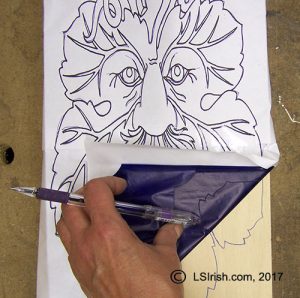 12. This second example is from the Wood Spirit Carving project posted on the Wood Carving Illustrated Forum. The pattern was transferred to the wood using typewriter carbon paper because the project would require intense handling.
12. This second example is from the Wood Spirit Carving project posted on the Wood Carving Illustrated Forum. The pattern was transferred to the wood using typewriter carbon paper because the project would require intense handling.
Relief Carving Wood Spirit Grape Man WIP – Over 250 detailed, close-up photos with step-by-step instructions of relief carving the wood spirit, green man face. This thread has had over 69,000 views!
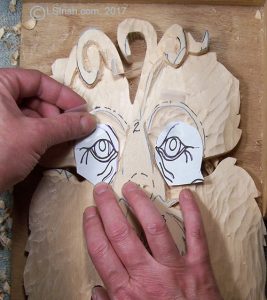 13. After the levels where established in the carving I cut my paper pattern into small sections that could be easily re-traced to the project.
13. After the levels where established in the carving I cut my paper pattern into small sections that could be easily re-traced to the project.
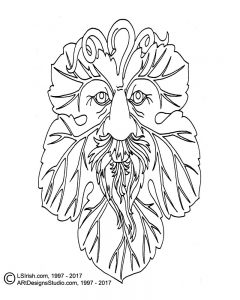 14. Click on the small image to the right for a free full-sized printable pattern.
14. Click on the small image to the right for a free full-sized printable pattern.